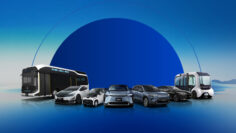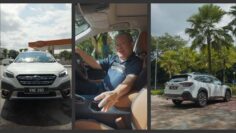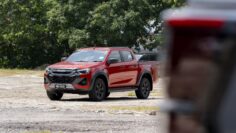The Subaru Outback is a lot more than just a family vehicle; it comes packed with a host of safety features, and it is equipped with Subaru’s unique Eyesight 4.0 class-leading technology.
Subaru Eyesight 4.0 is Subaru’svery own Driver Assist Technology that uses a unique two-camera system, which is akin to a pair of human eyes. This system is said to be superior to conventional radar or single-camera systems. Subaru Eyesight 4.0 features include the following
- Autonomous Emergency Braking and Pre-Collision Management that senses an impending collision and applies the brakes automatically if the driver fails to do so to avoid a collision or to mitigate damage.
- Pre-Collision Braking:
Detects potential collisions and automatically applies the brakes to help avoid or mitigate impacts. - Pre-Collision Throttle Management:
Reduces engine power in potential danger situations to give the driver more time to react. - Adaptive Cruise Control With Lane Centering that allows you to follow the flow of traffic safely, and Lane Centering keeps you in the center of the lane instead of bouncing from one side of the lane to the other. The Subaru system works even on curves.
- Lane Departure Prevention:
Assists in preventing the vehicle from unintentionally crossing lane markings by steering the vehicle back into its lane. - Lane Departure and Sway Warning:
Alerts the driver if the vehicle is drifting towards the edge of the lane or swaying excessively. - Autonomous Emergency Steering:
If a potential collision is detected and the driver does not react, the system can automatically steer the vehicle away from the obstacle. This is especially beneficial especially if the driver suffers a sudden collapse or is momentarily distracted. - Lead Vehicle Start Alert:
Warns the driver if the vehicle in front has started to move when stopped in traffic. I find this feature very useful at traffic lights that take a long time to change and I get distracted. - Subaru Rear Vehicle Detection:
(SRVD) Uses radar sensors to check for approaching traffic from the rear when changing lanes, backing up, or reversing. This feature is really useful when you are in tight situations with lots of traffic around you. - Blind-Spot Detection with Lane Change Assist: Alerts drivers to vehicles in their blind spots and assists with lane changes.
- Rear Cross-Traffic Alert: Warns drivers of approaching traffic from the sides when reversing.
- Reverse Automatic Braking (RAB): Automatically applies the brakes to help avoid collisions when backing up.
- High Beam Assist: Automatically toggles high beams on and off based on driving conditions.

Whilst the Subaru Outback’s Eyesight 4.0 technology does make it a very safe vehicle, the nomenclature, or how the car is built, also plays an important role in contributing to its overall safety, and here’s why!
Subaru Global Platform – Commonly referred to in abbreviated form as SGP, it allows for excellent visibility for the driver, with minimum blind spots. SGP also uses Macpherson struts at the front, and a double wishbone setup at the rear suspension which results in an excellent ride comfort while providing excellent road-holding. SGP also utilizes high strength steel that helps the body to withstand structural damage. The SGP is developed from Subaru’s extensive motorsport experience and it is also inspired by the BR-Z sports car set up.
The Boxer Engine with its horizontally opposing 4-cylinders is low in height, and thus gives the Subaru Outback a lower center of gravity, and therefore makes the vehicle more stable. A low mounting point also results in a lower bonnet line, this contributing to better visibility for the driver.
Symmetrical AWD System (S-AWD)– The Subaru Outback also features Subaru’s unique Symmetrical AWD system, and anyone who has experienced a Subaru XV, Legacy, WRX, Sti or the Outback will know what I mean. The Symmetrical AWD system provides excellent grip under all conditions, and in rainy weather, while others are struggling, the Subaru Outback will shine. This is because the S-AWD delivers drive to both the front and rear axles.

Active Torque Vectoring shifts the power to the outside wheels during cornering, and helps the Subaru Outback main positive grip at all times. The benefit is better handling and greater safety.
Airbag System: The Outback comes standard with dual frontal airbags, front seat-mounted side impact airbags, driver’s knee airbag, and side curtain airbags for all rows. This brings the total number of airbags to seven
When it comes to safety, the Subaru Outback ticks all the boxes, and therefore is worth considering if the intending user places high importance on driver and passenger protection.



![[ID: m-d-HadfhOQ] Youtube Automatic](https://media.yskhongdriving.com/2025/05/08124053/id-m-d-hadfhoq-youtube-automatic-60x60.jpg)
![[ID: W5q7EFjsij4] Youtube Automatic](https://media.yskhongdriving.com/2025/05/08124050/id-w5q7efjsij4-youtube-automatic-60x60.jpg)

![[ID: Re2unwVDEaI] Youtube Automatic](https://media.yskhongdriving.com/2025/05/15081611/id-re2unwvdeai-youtube-automatic-236x133.jpg)

![[ID: UBoJxjaGMy8] Youtube Automatic](https://media.yskhongdriving.com/2025/04/07080407/id-ubojxjagmy8-youtube-automatic-236x133.jpg)
![[ID: 7uNVLB75eWE] Youtube Automatic](https://media.yskhongdriving.com/2025/04/02175132/id-7unvlb75ewe-youtube-automatic-236x133.jpg)
